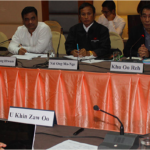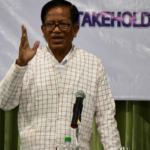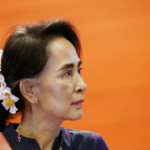By Sai Wansai/ Shan Herald Agency for New (SHAN) | October 25, 2016
As the war in Kachin and Shan States has been going on and off for a few years, with a newly exploded rebellion of the Rohingya in Arakan State, the peace negotiation limps along even though the State Counselor Aung San Suu Kyi has declared that time is running out to end the conflict, attaching rigid time-frame to speed up the process.
The political dialogue framework review and political talks, following the first anniversary occasion in Naypyitaw on 15 October, at the National Reconciliation and Peace Center (NRPC) in Yangon, was said to be able to agree the four from eight points United Nationalities Federal Council’s (UNFC) proposal to be included in the Nationwide Ceasefire Agreement (NCA).
The meeting from 18 to 20 October agreed four points were:
- Establishment of a federal union;
- Composition in political dialogue (Please note: it is not mentioned as tripartite dialogue);
- Constitutional amendment according to the results of the political dialogue; and
- To engage in heavy impact projects only in accordance with Extractive Industries Transparency Initiative (EITI).
The other four points that still need to be ironed out are:
- To have Military Code of Conduct (CoC) and Joint Ceasefire Monitoring Committee’s (JMC) Terms of Reference (TOR), which were already drafted and agreed in November 2015 and copies given to Delegation for Political Dialogue (DPN) – negotiation organ of UNFC -for consideration after the meeting;
- Involvement of foreign agencies and experts – in JMC & NCA enforcement organs -is agreed in principle, but need to discuss to what extent they should be involved; and
- Discussion of ceasefire declaration after the other points tabled by the DPN have been agreed upon.
According to the Union Peace Dialogue Joint Committee (UPDJC), which is the highest organ that would oversee the NCA implementation or peace process, its Chairperson Suu Kyi would officially endorse the draft, on 28 October, that has been reviewed and agreed upon by the UPDJC members, which the UNFC’s DPN would not be included, as it is a non-signatory of the NCA. To be a member in the UPDJC, one has to be a NCA signatory, according to the NCA guideline.
UPDJC is made up of 16 members each from three blocs: government, parliament and military; Ethnic Armed Organizations (EAOs); and political parties, involving 48 members altogether.
The only problem is whether the DPN’s remaining four point proposal will be included, as it is only allowed to be involved in review and suggestion section and not endorsing the draft with voting rights. Thus, it could not be sure if its remaining points of suggestion would be included in the Suu Kyi’s approved FPD, coupled with TOR.
If the UPDJC includes what the DPN wanted, the signing of NCA for the UNFC would be easier, but if not all will be back to the square one, that only enables to conduct a partial-ceasefire agreement and the 21st Century Panglong Conference (21CPC) that is far from being all-inclusive.
Pressures on UNFC
As it is now, the UNFC is being pushed from all sides national and international to sign the NCA, without bothering to ask why it has resisted to do so.
Apart from opinion-makers of all strips, the most outstanding soliciting and advocacy comes from the European Union, United States and lately from the International Crisis Group, funded by various governments, based in Brussels.
European Union (EU)
According to Shan Human Rights Foundation (SHRF), on 16 May 2016, the delegation which included the EU ambassador to Burma Roland Kobia and other EU diplomats including Poland’s ambassador Miroslaw Zapata, met with a number of people during the visit including both political and military representatives as well as community leaders and civil society groups. They also met with refugees displaced by the conflict.
“Fighting was ongoing just a few kilometers away from our meetings. We hope that the conflict parties in Shan State will soon lay down their arms and return to the negotiating table,” Kobia said in the statement.
“We came here to learn more about the reasons and root causes of the conflict. The ones who suffer most are always the civilians. In all our encounters with local leaders here we sent out a message that it is time for reconciliation, peace and ensuing socio-economic development,” Kobia added.
His call for disarmament was met with EAOs’ rejection and blame for not understanding the nature of ethnic resistance against political injustice.
United States
According to Eleven Media Group, during his Kachin State visit from 26 to 28 September 2016, the US ambassador Scot Marciel has told a Myitkyina-based technical advisory team for the Kachin Independence Organization (KIO) to participate in the ceasefire with Naypyitaw, according to Daung Kha of the team.
However, on 3 October 2016, he said that the United States will not put pressure or any ethnic armed organization that is yet sign to the NCA, according to one ethnic armed report that came out following that meeting with US ambassador Scott Marciel in Rangoon.
“The US embassy wants to inform stakeholders its action and intention to support the ongoing peace process,” he was quoted as saying. “It will support the building of a federal union and most assistance will be done under USAID program. Furthermore, it will not put any pressure on any group that has not signed the NCA.”
The statement appears to be in response to media reports late last month that he, during a visit to Kachin State capital Myitkyina, had urged the Kachin Independence Organization/Army (KIO/KIA) to sign the NCA with Naypyitaw, says the report.
International Crisis Group (ICG)
The ICG reports have always been biased where Burma is concerned and especially, in its position of supporting the government’s political agenda of the day, albeit at times thinly veiled and at another quite openly.
Its latest report “Myanmar’s Peace Process: Getting to a Political Dialogue”, in its concluding remark said: “It will take difficult negotiations to convince most groups to sign the NCA, a sine qua non the government and military have each expressed.”
Adding: “Armed groups need to recognize that, though they have legitimate concerns about the process, they may never get a better chance to negotiate a settlement.”
The advocacy concluded saying: “ Now is the time to start discussing the contours of that deal, rather than continuing to focus on preliminaries.”
In short, the thrust of the message is that even though the NCA maybe flawed this is the last chance that the EAOs would probably get, which in effect means a sort of “do or die” situation for them. In other words, the EAOs should go along, for something is better than nothing.
Let us see if this assumption is a valid assessment and if going along with the peace treaty, which the non-signatory EAOs consider to be unfair, starting with the composition of participation – meaning: rejection or unclear stance to accept tripartite dialogue – to military pressure and refusal to handle the peace process in a holistic manner, could be beneficial for them and the people of Burma. To put it differently, whether this hush-hush pushing to sign the problematic NCA would indeed ushered the country into a new era of harmony and reconciliation.
But let us now also look at the pressure stemming from the government, military and NCA signatory EAOs.
Pressure from government, military and the signatory EAOs
State Counselor Aung San Suu Kyi’s main message during the 21CPC, on 31 August 2016, was her regime’s adherence of the NCA, formally endorsed by the parliament during the previous government tenure and her willingness that the non-signatory EAOs to sign the agreement.
She said: “National reconciliation also includes reconciliation between EAOs. If there is difference of opinion between signatory and non-signatory groups, our peace journey would be delayed. In order not to have misunderstanding and difference of opinion, we are trying to have all groups under the shadow NCA’s umbrella, which emphasizes the common agreement.”
In the same vein, Commander-in-Chief Min Aung Hlaing has repeatedly aired his opinion that there is no other way for the non-signatory EAOs to participate in national political dialogue, other than first signing the NCA.
During the recent NCA signing first anniversary, on 15 October, Min Aung Hlaing in his speech said: “The NCA was drafted through a series of discussions between the Union Peace-making Work Committee and representatives from ethnic armed groups. The NCA was drafted only after all participants reached a detailed agreement on each chapter, section, paragraph and wording. Under various circumstances, some organizations included in the NCA drafting process were not ready to sign the NCA. Primarily some groups signed the NCA.”
He stressed : “So, we are trying for the participation of all the non-signatories. The door is still opened and they are always welcomed. As the foundation of the peace process was laid on the facts negotiated and agreed by them, their aspiration can be reflected through their participation in the process. The agreements contained in the NCA are broader than the term “ceasefire”. It can obviously be seen that the chapter 1 and chapter 5 of the NCA describe “Our Three Main National Causes”, which are the country’s national needs and interests, twice.”
He made his point, when he outlined: “For our country to obtain peace and stability, ethnic armed conflicts must be ended. It needs to carry out the processes to bring ethnic armed conflicts to an end in line with the international procedures. The NCA (Nationwide Ceasefire Agreement) is the initial step of processes.”
He buttressed it with the urging that the ethnic armed groups should sign the NCA.
The NCA signatory EAOs also heap the pressure on the UNFC when the Chin National Front (CNF) and Pa-O National Liberation Organization (PNLO) representatives also told the media that without signing the NCA, the UNFC won’t be able to become members of the UPDJC and would not be able to vote for the possible amendments of NCA.
The PNLO patron, Hkun Okker echoed Suu Kyi’s line of reasoning that time is running out and no time to wait, but failed to come to the aid of sound reasoning that the DPN has tabled to be resolved before asking Suu Kyi to officially endorse it.
Perspective
The cardinal question to be asked here is why are well-meaning national and international influential actors so obsessed with the UNFC signing the NCA and haven’t bother to pose the question of why it is still reluctant to sign.
The simple answer would be the failure to commit to the bilateral ceasefire, all-inclusive participation and equitable composition of participation, without condition, at all levels by the government and the military in the peace process.
The military’s offensive pressures in the field against the EAOs and peace process donors’ any amount of coaxing, to sign the NCA without question, won’t be able to distract the expression of “Nothing is agreed until everything is agreed”, which in different international documents, is taken as “principle”, “mantra”, “Golden Rule”, “legal principle” and even “standard principle”.
Like Min Aung Hlaing rightly pointed out that the NCA has not only to do with ceasefire, but includes political settlement that would alter or rewrite the constitution. And as such, one would be insane to go along with the thinking of amending the treaty later as the negotiation process progress and not to be too particular in signing the treaty now even though the treaty is not perfect, as the ICG has suggested.
True, adjustment to the implementation of the treaty could arise, but the basic principles and agreement could not be altered in anyway. And explicitly means bilateral ceasefire, all-inclusive participation and equitable composition of participation are the three core basic necessities, without which, the whole process would breakdown even before starting.
The UPDJC did entertain the discussion to incorporate the UNFC’s eight point proposal, but didn’t pull through to the end and instead would only abide by the deadline of 28 October, prescribed by Suu Kyi with what have been agreed upon so far and not all the proposals being tabled. In other words, the remaining four points that are pending would remain untouched.
In sum, the final endorsement of FPD, including the National – State/Regional level – Political Dialogue (NPD) and the corresponding TOR would not be comprehensive enough as the UNFC has asked for.
Because of such circumstances, those who are pressuring the UNFC to sign the NCA should first ask the government and military to fulfill the three core demands, before indulging in soliciting the UNFC to sign the treaty without reservation, which if it is done would amount to “surrendered peace,” and not the “compromised political settlement.”
This article originally appeared on Shan Herald Agency for News (SHAN) on October 23, 2016.







